Macduff Shipyards’ boatbuilding facility in Buckie, Scotland has delivered a new trawler, Forever Faithful, to Peterhead-based fishing boat owner Andrew West. The newbuild – which replaces West’s previous vessel of the same name, built at the Buckie site in 2016 – will be used to net prawns in the North Sea.
The new Forever Faithful was jointly designed by the yard and Macduff Ship Design. In the vessel’s initial design phase, Southampton University’s Wolfson Unit ran a CFD case study of two hullforms: the first being that of the original Forever Faithful; the second, a new concept model featuring: “increased length; a gradual bustle forward of the propeller; and a unique stem where the bulbous bow was not fully submerged, but rather tapered gradually into the bow’s upper region”, Macduff Ship Design explains. The case study indicated a significant reduction in hull resistance at the two test speeds (8knots and 10knots), with the new vessel steaming 1knot faster at full power than the original vessel, both on the same engine. “This increase in hull efficiency enables the owner to run the engine at a lower loading to save fuel…and reduce emissions,” says Macduff Ship Design.
Forever Faithful has a steel hull with a double chine hullform, while the wheelhouse and mast are fashioned from aluminium. The vessel measures 22.75m in overall length, 7.6m in beam and 4.15m in depth, and has a hold capacity of 600 boxes. The trawler also has the capacity for six to eight crew members, plus 25,000litres of fuel oil and 13,000litres of fresh water.
Power is derived from a single Caterpillar C18 main engine with a power output of just over 447kW. The engine is fitted with an SCR unit and a urea pumping system, to comply with IMO Tier III emissions regulations. The trawler has also been fitted with a Masson Marine W6000 gearbox with a 10:1 reduction. Macduff Ship Design says: “This gearbox allowed the yard to fit a 2.5m-diameter propeller, fitted within a modern-profile nozzle duct – providing high thrust at low speeds, but also a slight increase of thrust at steaming speeds compared to the previous vessel.” This set-up grants the trawler a speed of 10knots. Additionally, in sea trials, the 35dB reduction SCR silencer was shown to help reduce noise levels throughout the 224gt boat.
The trawler’s hydraulic deck machinery package includes a triple barrel winch with a Hagglunds CA210 motor, plus two split net drums featuring twin Hagglunds CA70 motors per drum. Thistle Marine supplied the boat’s MFB8 landing crane and MBK7 power block crane. A Doosan/Hyundai 4AD086 auxiliary engine, rated 199kW, provides the vessel’s primary hydraulic power.
When the catch has been lifted on board, it is moved by hydraulic conveyor to the working deck, to be sorted and washed. “Once washed, the catch is packed at the forward end of the working deck before being taken into a blast room on the forward port side, where the prawns are frozen at -35° C to -40° C for around four to six hours,” Macduff Ship Design explains. The blast room can store up to 1,000kg of packed product. Once frozen, the product is lowered into the cold store – situated directly below, in the aft section of the hold – until it is offloaded on shore.
Macduff Ship Design says: “A bulkhead divides the fish hold into two. The forward part of the hold is arranged as a traditional wet fish hold with its own chilling system, capable of holding around 250 boxes of chilled fish.” All of the freezing and refrigeration systems in the hold were supplied by Premier Refrigeration.




